Effects of Substrates on Nucleation, Growth and Electrical Property of Vertical Few-Layer Graphene
Abstract
:1. Introduction
2. Materials and Methods
2.1. Preparation of VFLG
2.2. Characterization
3. Results and Discussion
4. Conclusions
Supplementary Materials
Author Contributions
Funding
Data Availability Statement
Acknowledgments
Conflicts of Interest
References
- Chen, L.; Yu, H.; Zhong, J.; Song, L.; Wu, J.; Su, W. Graphene Field Emitters: A Review of Fabrication, Characterization and Properties. Mater. Sci. Eng. B 2017, 220, 44–58. [Google Scholar] [CrossRef]
- Wang, H.; Gao, E.; Liu, P.; Zhou, D.; Geng, D.; Xue, X.; Wang, L.; Jiang, K.; Xu, Z.; Yu, G. Facile Growth of Vertically-Aligned Graphene Nanosheets via Thermal CVD: The Experimental and Theoretical Investigations. Carbon 2017, 121, 1–9. [Google Scholar] [CrossRef]
- Qi, J.L.; Wang, X.; Zheng, W.T.; Tian, H.W.; Hu, C.Q.; Peng, Y.S. Ar Plasma Treatment on Few Layer Graphene Sheets for Enhancing Their Field Emission Properties. J. Phys. D Appl. Phys. 2010, 43, 055302. [Google Scholar] [CrossRef]
- Rout, C.S.; Joshi, P.D.; Kashid, R.V.; Joag, D.S.; More, M.A.; Simbeck, A.J.; Washington, M.; Nayak, S.K.; Late, D.J. Enhanced Field Emission Properties of Doped Graphene Nanosheets with Layered SnS2. Appl. Phys. Lett. 2014, 105, 043109. [Google Scholar] [CrossRef]
- Guo, X.; Qin, S.C.; Bai, S.; Yue, H.W.; Li, Y.L.; Chen, Q.; Li, J.S.; He, D.Y. Vertical Graphene Nanosheets Synthesized by Thermal Chemical Vapor Deposition and the Field Emission Properties. J. Phys. D Appl. Phys. 2016, 49, 385301. [Google Scholar] [CrossRef]
- Zhang, Y.; Du, J.L.; Tang, S.; Liu, P.; Deng, S.Z.; Chen, J.; Xu, N.S. Optimize the Field Emission Character of a Vertical Few-Layer Graphene Sheet by Manipulating the Morphology. Nanotechnology 2012, 23, 015202. [Google Scholar] [CrossRef]
- Tang, S.; Zhang, Y.; Zhao, P.; Zhan, R.Z.; Chen, J.; Deng, S.Z. Realizing the Large Current Field Emission Characteristics of Single Vertical Few-Layer Graphene by Constructing a Lateral Graphite Heat Dissipation Interface. Nanoscale 2021, 13, 5234–5242. [Google Scholar] [CrossRef]
- Jiang, L.L.; Yang, T.Z.; Liu, F.; Dong, J.; Yao, Z.H.; Shen, C.M.; Deng, S.Z.; Xu, N.S.; Liu, Y.Q.; Gao, H.J. Controlled Synthesis of Large-Scale, Uniform, Vertically Standing Graphene for High-Performance Field Emitters. Adv. Mater. 2013, 25, 250–255. [Google Scholar] [CrossRef]
- Wang, F.J.; Deng, L.N.; Deng, J.H. Facile Synthesis of Differently Shaped, Ultrathin, and Aligned Graphene Flakes without a Catalyst for Highly Efficient Field Emission. Appl. Surf. Sci. 2015, 355, 218–225. [Google Scholar] [CrossRef]
- Wu, Y.; Qiao, P.; Chong, T.; Shen, Z. Carbon Nanowalls Grown by Microwave Plasma Enhanced Chemical Vapor Deposition. Adv. Mater. 2002, 14, 64–67. [Google Scholar] [CrossRef]
- Ghosh, S.; Polaki, S.R.; Kumar, N.; Amirthapandian, S.; Kamruddin, M.; Ostrikov, K.K. Process-Specific Mechanisms of Vertically Oriented Graphene Growth in Plasmas. Beilstein. J. Nanotechnol. 2017, 8, 1658–1670. [Google Scholar]
- Wang, J.; Zhu, M.; Outlaw, R.A.; Zhao, X.; Manos, D.M.; Holloway, B.C. Synthesis of Carbon Nanosheets by Inductively Coupled Radio-Frequency Plasma Enhanced Chemical Vapor Deposition. Carbon 2004, 42, 2867–2872. [Google Scholar] [CrossRef]
- Wu, Z.H.; Zhang, Y.S.; Shen, Y.L.; Zhang, W.; Shao, G.S. Heater-Free and Substrate-Independent Growth of Vertically Standing Graphene Using a High-Flux Plasma-Enhanced Chemical Vapor Deposition. Adv. Mater. Interfaces 2020, 7, 2000854. [Google Scholar] [CrossRef]
- Wang, Z.P.; Ogata, H.; Morimoto, S.; Fujishige, M.; Takeuchi, K.; Muramatsu, H.; Hayashi, T.; Ortiz-Medina, J.; Yusop, M.Z.M.; Tanemura, M.; et al. Microwave Plasma-Induced Graphene-Sheet Fibers from Waste Coffee Grounds. J. Mater. Chem. A 2015, 3, 14545–14549. [Google Scholar] [CrossRef]
- Cui, L.; Chen, J.; Yang, B.; Sun, D.; Jiao, T. RF-PECVD Synthesis of Carbon Nanowalls and Their Field Emission Properties. Appl. Surf. Sci. 2015, 357, 1–7. [Google Scholar] [CrossRef]
- Yang, C.; Bi, H.; Wan, D.; Huang, F.; Xie, X.; Jiang, M. Direct PECVD Growth of Vertically Erected Graphene Walls on Dielectric Substrates as Excellent Multifunctional Electrodes. J. Mater. Chem. A 2013, 1, 770–775. [Google Scholar] [CrossRef]
- Lehmann, K.; Yurchenko, O.; Urban, G. Effect of The Aromatic Precursor Flow Rate on The Morphology and Properties of Carbon Nanostructures in Plasma Enhanced Chemical Vapor Deposition. RSC Adv. 2016, 6, 32779–32788. [Google Scholar] [CrossRef] [Green Version]
- Van Nang, L.; Kim, E.T. Controllable Synthesis of High-Quality Graphene Using Inductively-Coupled Plasma Chemical Vapor Deposition. J. Electrochem. Soc. 2012, 159, K93–K96. [Google Scholar] [CrossRef]
- Hiramatsu, M.; Nihashi, Y.; Kondo, H.; Hori, M. Nucleation Control of Carbon Nanowalls Using Inductively Coupled Plasma-Enhanced Chemical Vapor Deposition. Jpn. J. Appl. Phys. 2013, 52, 01AK05. [Google Scholar] [CrossRef]
- Kim, S.Y.; Joung, Y.H.; Choi, W.S. Growth Properties of Carbon Nanowalls on Glass Substrates by a Microwave Plasma-Enhanced Chemical Vapor Deposition. Jpn. J. Appl. Phys. 2014, 53, 05FD09. [Google Scholar] [CrossRef]
- Ghosh, S.; Ganesan, K.; Polaki, S.R.; Mathews, T.; Dhara, S.; Kamruddin, M.; Tyagi, A.K. Influence of Substrate on Nucleation and Growth of Vertical Graphene Nanosheets. Appl. Surf. Sci. 2015, 349, 576–581. [Google Scholar] [CrossRef]
- Guo, C.; Xu, N.S.; Zhang, Y.; Ke, Y.L.; Chen, J.; She, J.C.; Deng, S.Z. One-step Growth of Graphene-Carbon Nanotube Trees on 4’’ Substrate and Characteristics of Single Individual Tree. Carbon 2017, 125, 189–198. [Google Scholar] [CrossRef]
- Ma, Y.F.; Jiang, W.; Han, J.M.; Tong, Z.M.; Wang, M.; Suhr, J.; Chen, X.Y.; Xiao, L.T.; Jia, S.T.; Chae, H. Experimental Investigation on Vertically Oriented Graphene Grown in a Plasma-Enhanced Chemical Vapor Deposition Process. ACS Appl. Mater. Interfaces 2019, 11, 10237–10243. [Google Scholar] [CrossRef] [PubMed]
- Zhu, M.Y.; Wang, J.J.; Outlaw, R.A.; Hou, K.; Manos, D.M.; Holloway, B.C. Synthesis of Carbon Nanosheets and Carbon Nanotubes by Radio Frequency Plasma Enhanced Chemical Vapor Deposition. Diam. Relat. Mater. 2007, 16, 196–201. [Google Scholar] [CrossRef]
- Kim, S.Y.; Choi, W.S.; Lee, J.H.; Hong, B. Substrate Temperature Effect on the Growth of Carbon Nanowalls Synthesized via Microwave PECVD. Mater. Res. Bull. 2014, 58, 112–116. [Google Scholar] [CrossRef]
- Ohring, M. Materials Science of Thin Films, 2nd ed.; Elsevier: Amsterdam, The Netherlands, 2001; pp. 199–230. [Google Scholar]
- Schimka, L.; Harl, J.; Stroppa, A.; Grüneis, A.; Marsman, M.; Mittendorfer, F.; Kresse, G. Accurate Surface and Adsorption Energies Frommany-Body Perturbation Theory. Nat. Mater. 2010, 9, 741–744. [Google Scholar] [CrossRef]
- Sun, L.; Chen, X.F.; Yu, W.C.; Sun, H.G.; Zhao, X.; Xu, X.G.; Yu, F.; Liu, Y.F. The Effect of the Surface Energy and Structure of the SiC Substrate on Epitaxial Graphene Growth. RSC Adv. 2016, 6, 100908–100915. [Google Scholar] [CrossRef]
- Peng, S.A.; Jin, Z.; Ma, P.; Zhang, D.Y.; Shi, J.Y.; Niu, J.B.; Wang, X.Y.; Wang, S.Q.; Li, M.; Liu, X.Y.; et al. The Sheet Resistance of Graphene Under Contact and its Effect on the Derived Specific Contact Resistivity. Carbon 2015, 82, 500–505. [Google Scholar] [CrossRef]
- Wu, Y.Q.; Wu, Y.; Kang, K.; Chen, Y.F.; Li, Y.R.; Chen, T.S.; Xu, Y.H. Characterization of CVD Graphene Permittivity and Conductivity in Micro-/Millimeter Wave Frequency Range. AIP Adv. 2016, 6, 095014. [Google Scholar] [CrossRef] [Green Version]
- Suk, J.W.; Kitt, A.; Magnuson, C.W.; Hao, Y.F.; Ahmed, S.; An, J.; Swan, A.K.; Goldberg, B.B.; Ruoff, R.S. Transfer of CVD-Grown Monolayer Graphene onto Arbitrary Substrates. ACS Nano 2011, 5, 6916–6924. [Google Scholar] [CrossRef]
- Xu, Z.M.; Ferraro, D.; Zaltron, A.; Galvanetto, N.; Martucci, A.; Sun, L.Z.; Yang, P.F.; Zhang, Y.F.; Wang, Y.C.; Liu, Z.F.; et al. Optical Detection of the Susceptibility Tensor in Two-Dimensional Crystals. Commun. Phys. 2021, 4, 215. [Google Scholar] [CrossRef]
- Gugel, D.; Niesner, D.; Eickhoff, C.; Wagner, S.; Weinelt, M.; Fauster, T. Two-Photon Photoemission from Image-Potential States of Epitaxial Graphene. 2D Mater. 2015, 2, 045001. [Google Scholar] [CrossRef] [Green Version]
- Wang, X.Q.; Wang, M.; Li, Z.H.; Xu, Y.B.; He, P.M. Modeling and Calculation of Field Emission Enhancement Factor for Carbon Nanotubes Array. Ultramicroscopy 2005, 102, 181–187. [Google Scholar] [CrossRef] [PubMed]
- Liu, Y.L.; Zhong, L.; Peng, Z.Y.; Song, Y.B.; Chen, W. Field Emission Properties of One-Dimensional Single CuO Nanoneedle by in Situ Microscopy. J. Mater. Sci. 2010, 45, 3791–3796. [Google Scholar] [CrossRef]
- Zhao, P.; Zhang, Y.; Tang, S.; Zhan, R.Z.; She, J.C.; Chen, J.; Xu, N.S.; Deng, S.Z. Effect of Piezoresistive Behavior on Electron Emission from Individual Silicon Carbide Nanowire. Nanomaterials 2019, 9, 981. [Google Scholar] [CrossRef] [PubMed] [Green Version]
- Shen, Y.; Xu, N.S.; Deng, S.Z.; Zhang, Y.; Liu, F.; Chen, J. A Mo Nanoscrew Formed by Crystalline Mo Grains with High Conductivity and Excellent Field Emission Properties. Nanoscale 2014, 6, 4659–4668. [Google Scholar] [CrossRef]
- Gan, H.B.; Peng, L.X.; Yang, X.; Tian, Y.; Xu, N.S.; Chen, J.; Liu, F.; Deng, S.Z. A Moderate Synthesis Route of 5.6 mA-Current LaB6 Nanowire Film with Recoverable Emission Performance Towards Cold Cathode Electron Source Applications. RSC Adv. 2017, 7, 24848. [Google Scholar] [CrossRef] [Green Version]
- Wang, M.S.; Peng, L.M.; Wang, J.Y.; Chen, Q. Electron Field Emission Characteristics and Field Evaporation of a Single Carbon Nanotube. J. Phys. Chem. B 2005, 109, 110–113. [Google Scholar] [CrossRef]
- Nakakubo, K.; Asaka, K.; Nakahara, H.; Saito, Y. Evolution of Field Electron Emission Pattern from Multilayered Graphene Induced by Structural Change of Edge. Appl. Phys. Express 2012, 5, 055101. [Google Scholar] [CrossRef]

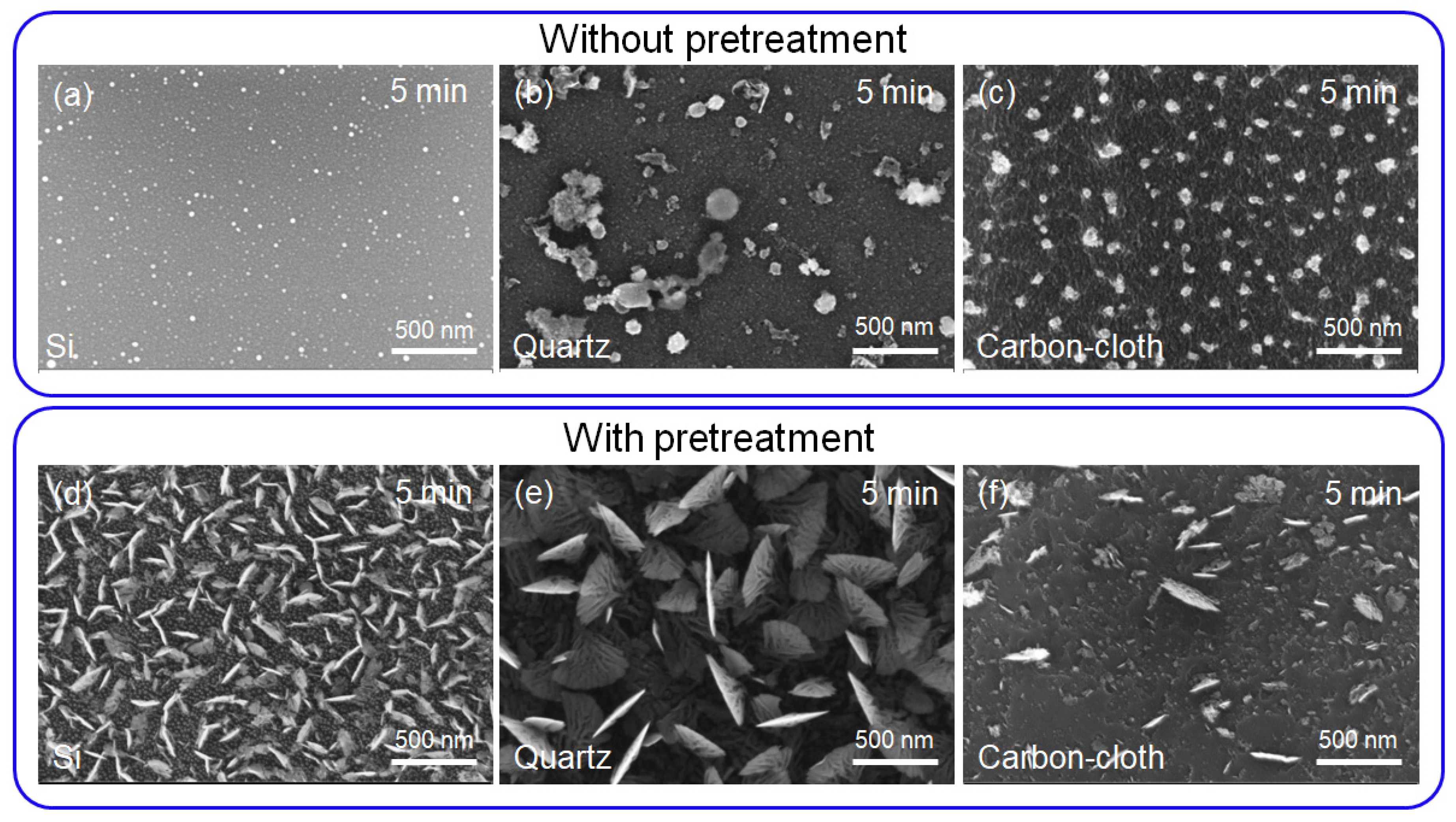
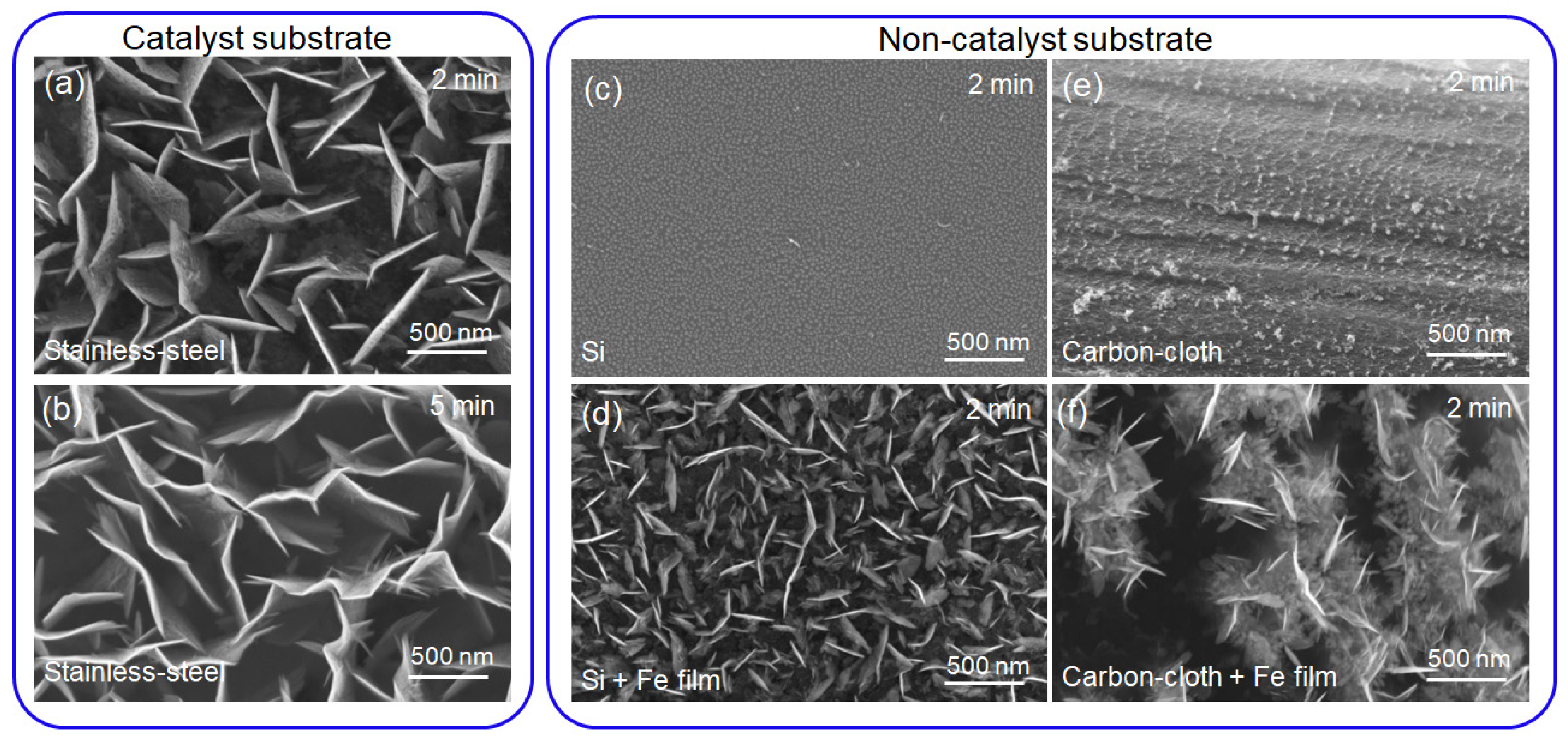
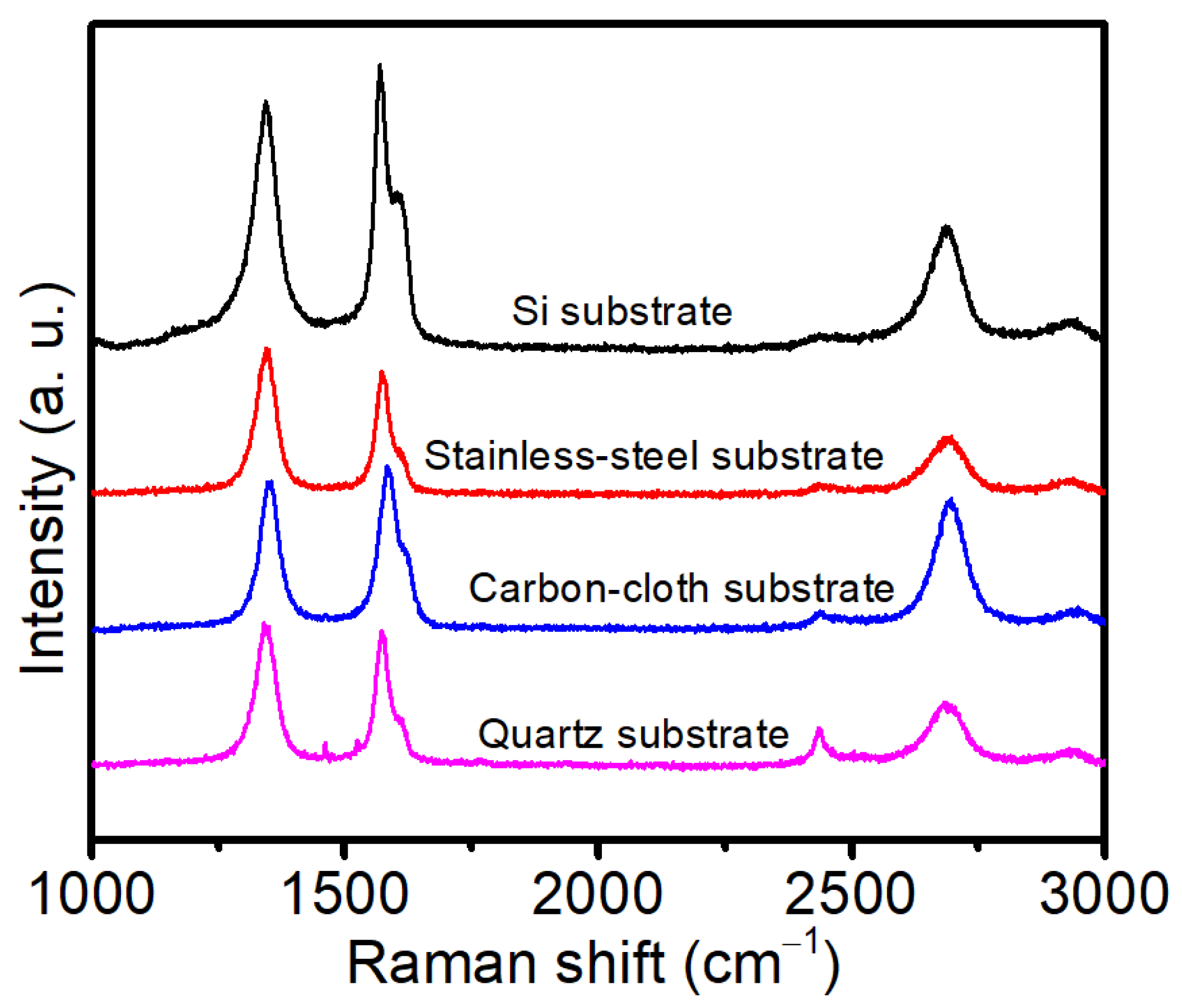

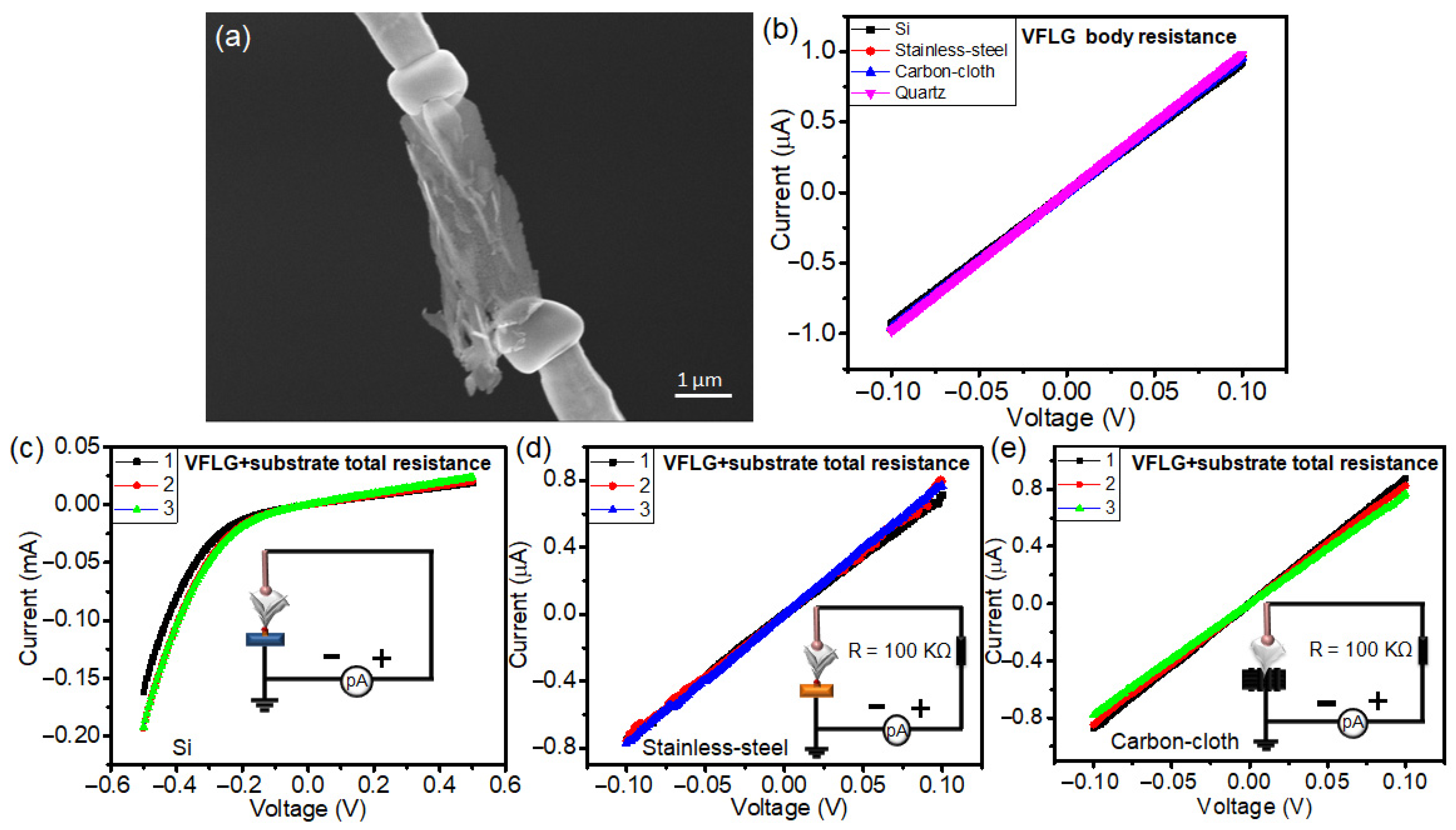
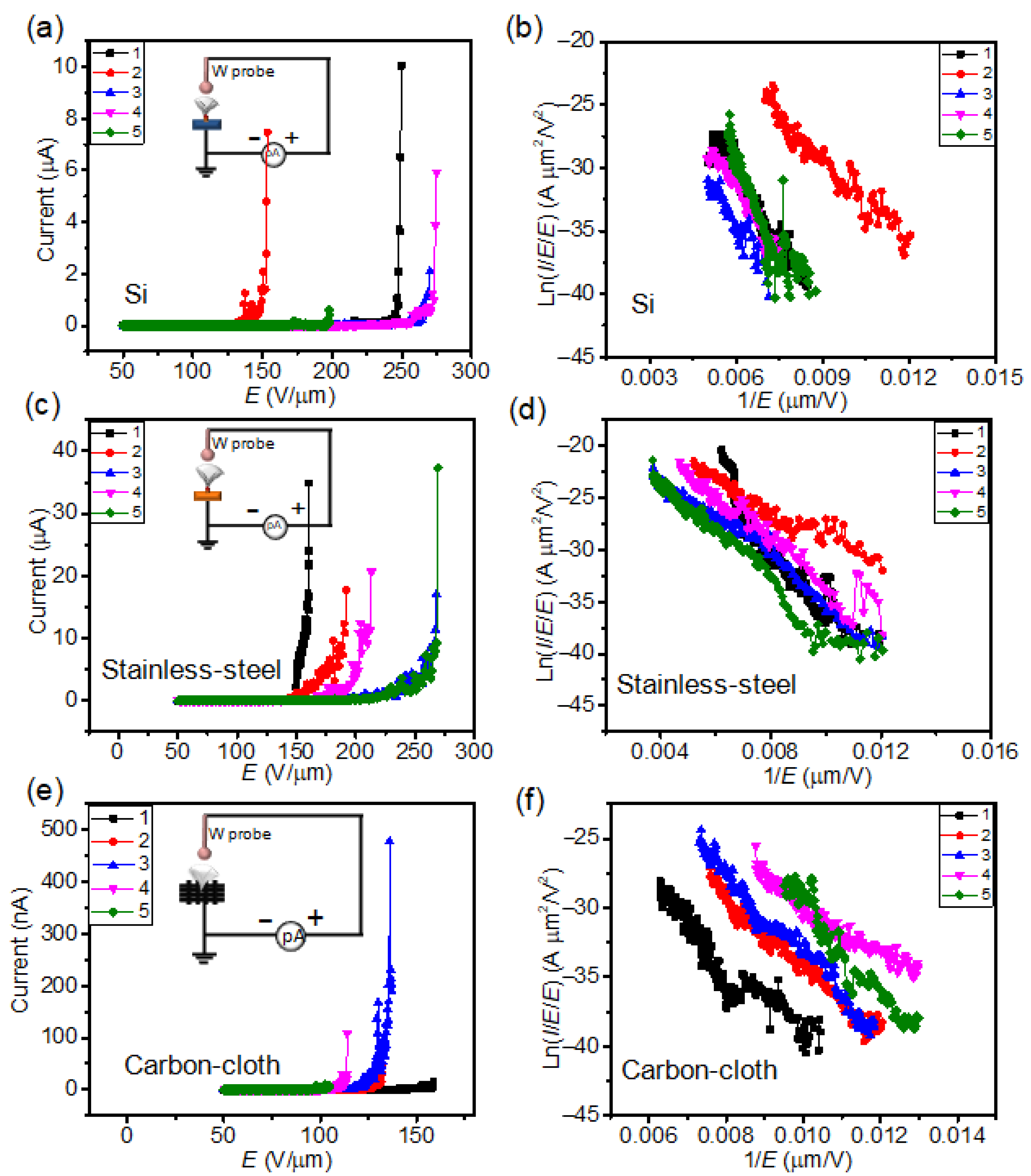
| Substrates | Contact Angle (°) | Catalysis | After Pretreatment Growth 2 min | After Pretreatment Growth 5 min | |
|---|---|---|---|---|---|
| Before Pretreatment | After Pretreatment | ||||
| Si | 66 | 32 | No | Without VFLG | VFLG |
| Carbon-cloth | 134 | 116 | No | Without VFLG | Few VFLG |
| Quartz | 50 | 35 | No | Without VFLG | VFLG |
| Stainless-steel | 71 | 107 | Yes | VFLG | VFLG |
| Substrate | ID/IG | I2D/IG | GFWHM (cm−1) | 2DFWHM (cm−1) |
|---|---|---|---|---|
| Si | 0.9 | 0.45 | 29 | 82 |
| Stainless-steel | 1.2 | 0.46 | 30 | 87 |
| Carbon-cloth | 0.93 | 0.8 | 39 | 72 |
| Quartz | 1.1 | 0.46 | 30 | 87 |
| Single Sheet/Wire/Tube Sample | VFLG | CuO Nanoneedle | SiC Nanowire | Mo Nanoscrew | LaB6 Nanowire | Carbon Nanotube | Multilayer Graphene |
|---|---|---|---|---|---|---|---|
| Maximum current (μA) | 35 | 1.08 | 1.07 | 15.8 | 96 | 65 | 60 |
| Current density (A/cm2) | 7.8 × 105 | - | 2.5 × 104 | 2 × 105 | 1.6 × 107 | - | 7 × 107 |
| Breakdown voltage (V/μm) | 160 | 9.7 | 220 | 160 | 320 | - | - |
| Ref. | Our work | [35] | [36] | [37] | [38] | [39] | [40] |
Publisher’s Note: MDPI stays neutral with regard to jurisdictional claims in published maps and institutional affiliations. |
© 2022 by the authors. Licensee MDPI, Basel, Switzerland. This article is an open access article distributed under the terms and conditions of the Creative Commons Attribution (CC BY) license (https://creativecommons.org/licenses/by/4.0/).
Share and Cite
Hong, T.; Guo, C.; Zhang, Y.; Zhan, R.; Zhao, P.; Li, B.; Deng, S. Effects of Substrates on Nucleation, Growth and Electrical Property of Vertical Few-Layer Graphene. Nanomaterials 2022, 12, 971. https://doi.org/10.3390/nano12060971
Hong T, Guo C, Zhang Y, Zhan R, Zhao P, Li B, Deng S. Effects of Substrates on Nucleation, Growth and Electrical Property of Vertical Few-Layer Graphene. Nanomaterials. 2022; 12(6):971. https://doi.org/10.3390/nano12060971
Chicago/Turabian StyleHong, Tianzeng, Chan Guo, Yu Zhang, Runze Zhan, Peng Zhao, Baohong Li, and Shaozhi Deng. 2022. "Effects of Substrates on Nucleation, Growth and Electrical Property of Vertical Few-Layer Graphene" Nanomaterials 12, no. 6: 971. https://doi.org/10.3390/nano12060971






